This article describes periodic points of some complex quadratic maps. A map is a formula for computing a value of a variable based on its own previous value or values; a quadratic map is one that involves the previous value raised to the powers one and two; and a complex map is one in which the variable and the parameters are complex numbers. A periodic point of a map is a value of the variable that occurs repeatedly after intervals of a fixed length.
These periodic points play a role in the theories of Fatou and Julia sets.
Definitions
Let
be the complex quadric mapping, where and are complex numbers.
Notationally, is the -fold composition of with itself (not to be confused with the th derivative of )—that is, the value after the k-th iteration of the function Thus
Periodic points of a complex quadratic mapping of period are points of the dynamical plane such that
where is the smallest positive integer for which the equation holds at that z.
We can introduce a new function:
so periodic points are zeros of function : points z satisfying
which is a polynomial of degree
Number of periodic points
The degree of the polynomial describing periodic points is so it has exactly complex roots (= periodic points), counted with multiplicity.
Stability of periodic points (orbit) - multiplier
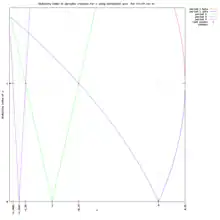
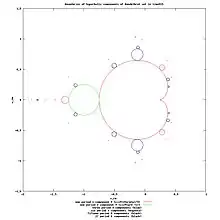

The multiplier (or eigenvalue, derivative) of a rational map iterated times at cyclic point is defined as:
where is the first derivative of with respect to at .
Because the multiplier is the same at all periodic points on a given orbit, it is called a multiplier of the periodic orbit.
The multiplier is:
- a complex number;
- invariant under conjugation of any rational map at its fixed point;[1]
- used to check stability of periodic (also fixed) points with stability index
A periodic point is[2]
- attracting when
- super-attracting when
- attracting but not super-attracting when
- indifferent when
- rationally indifferent or parabolic if is a root of unity;
- irrationally indifferent if but multiplier is not a root of unity;
- repelling when
Periodic points
Period-1 points (fixed points)
Finite fixed points
Let us begin by finding all finite points left unchanged by one application of . These are the points that satisfy . That is, we wish to solve
which can be rewritten as
Since this is an ordinary quadratic equation in one unknown, we can apply the standard quadratic solution formula:
- and
So for we have two finite fixed points and .
Since
- and where
we have .
Thus fixed points are symmetrical about .
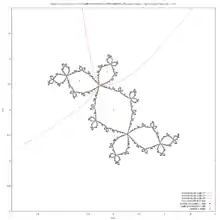
Complex dynamics
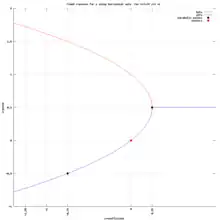
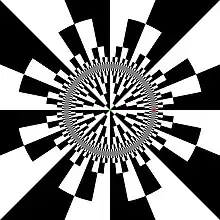
Here different notation is commonly used:[4]
- with multiplier
and
- with multiplier
Again we have
Since the derivative with respect to z is
we have
This implies that can have at most one attractive fixed point.
These points are distinguished by the facts that:
- is:
- the landing point of the external ray for angle=0 for
- the most repelling fixed point of the Julia set
- the one on the right (whenever fixed point are not symmetrical around the real axis), it is the extreme right point for connected Julia sets (except for cauliflower).[5]
- is:
- the landing point of several rays
- attracting when is in the main cardioid of the Mandelbrot set, in which case it is in the interior of a filled-in Julia set, and therefore belongs to the Fatou set (strictly to the basin of attraction of finite fixed point)
- parabolic at the root point of the limb of the Mandelbrot set
- repelling for other values of
Special cases
An important case of the quadratic mapping is . In this case, we get and . In this case, 0 is a superattractive fixed point, and 1 belongs to the Julia set.
Only one fixed point
We have exactly when This equation has one solution, in which case . In fact is the largest positive, purely real value for which a finite attractor exists.
Infinite fixed point
We can extend the complex plane to the Riemann sphere (extended complex plane) by adding infinity:
and extend such that
Then infinity is:
- superattracting
- a fixed point of :[6]
Period-2 cycles
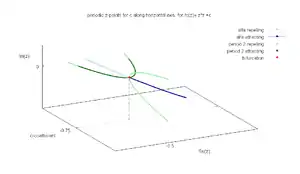
%253Dz*z_%252Bc.gif)
Period-2 cycles are two distinct points and such that and , and hence
for :
Equating this to z, we obtain
This equation is a polynomial of degree 4, and so has four (possibly non-distinct) solutions. However, we already know two of the solutions. They are and , computed above, since if these points are left unchanged by one application of , then clearly they will be unchanged by more than one application of .
Our 4th-order polynomial can therefore be factored in 2 ways:
First method of factorization
This expands directly as (note the alternating signs), where
We already have two solutions, and only need the other two. Hence the problem is equivalent to solving a quadratic polynomial. In particular, note that
and
Adding these to the above, we get and . Matching these against the coefficients from expanding , we get
- and
From this, we easily get
- and .
From here, we construct a quadratic equation with and apply the standard solution formula to get
- and
Closer examination shows that:
- and
meaning these two points are the two points on a single period-2 cycle.
Second method of factorization
We can factor the quartic by using polynomial long division to divide out the factors and which account for the two fixed points and (whose values were given earlier and which still remain at the fixed point after two iterations):
The roots of the first factor are the two fixed points. They are repelling outside the main cardioid.
The second factor has the two roots
These two roots, which are the same as those found by the first method, form the period-2 orbit.[7]
Special cases
Again, let us look at . Then
- and
both of which are complex numbers. We have . Thus, both these points are "hiding" in the Julia set. Another special case is , which gives and . This gives the well-known superattractive cycle found in the largest period-2 lobe of the quadratic Mandelbrot set.
Cycles for period greater than 2
_%253D_z*z-0.75_for_period_%253D6_as_intersections_of_2_implicit_curves.svg.png.webp)
The degree of the equation is 2n; thus for example, to find the points on a 3-cycle we would need to solve an equation of degree 8. After factoring out the factors giving the two fixed points, we would have a sixth degree equation.
There is no general solution in radicals to polynomial equations of degree five or higher, so the points on a cycle of period greater than 2 must in general be computed using numerical methods. However, in the specific case of period 4 the cyclical points have lengthy expressions in radicals.[8]
In the case c = –2, trigonometric solutions exist for the periodic points of all periods. The case is equivalent to the logistic map case r = 4: Here the equivalence is given by One of the k-cycles of the logistic variable x (all of which cycles are repelling) is
References
- ↑ Alan F. Beardon, Iteration of Rational Functions, Springer 1991, ISBN 0-387-95151-2, p. 41
- ↑ Alan F. Beardon, Iteration of Rational Functions, Springer 1991, ISBN 0-387-95151-2, page 99
- ↑ Some Julia sets by Michael Becker
- ↑ On the regular leaf space of the cauliflower by Tomoki Kawahira Source: Kodai Math. J. Volume 26, Number 2 (2003), 167-178. Archived 2011-07-17 at the Wayback Machine
- ↑ Periodic attractor by Evgeny Demidov Archived 2008-05-11 at the Wayback Machine
- ↑ R L Devaney, L Keen (Editor): Chaos and Fractals: The Mathematics Behind the Computer Graphics. Publisher: Amer Mathematical Society July 1989, ISBN 0-8218-0137-6 , ISBN 978-0-8218-0137-6
- ↑ Period 2 orbit by Evgeny Demidov Archived 2008-05-11 at the Wayback Machine
- ↑ Gvozden Rukavina : Quadratic recurrence equations - exact explicit solution of period four fixed points functions in bifurcation diagram
Further reading
- Geometrical properties of polynomial roots
- Alan F. Beardon, Iteration of Rational Functions, Springer 1991, ISBN 0-387-95151-2
- Michael F. Barnsley (Author), Stephen G. Demko (Editor), Chaotic Dynamics and Fractals (Notes and Reports in Mathematics in Science and Engineering Series) Academic Pr (April 1986), ISBN 0-12-079060-2
- Wolf Jung : Homeomorphisms on Edges of the Mandelbrot Set. Ph.D. thesis of 2002
- The permutations of periodic points in quadratic polynominials by J Leahy
External links
- Algebraic solution of Mandelbrot orbital boundaries by Donald D. Cross
- Brown Method by Robert P. Munafo
- arXiv:hep-th/0501235v2 V.Dolotin, A.Morozov: Algebraic Geometry of Discrete Dynamics. The case of one variable.